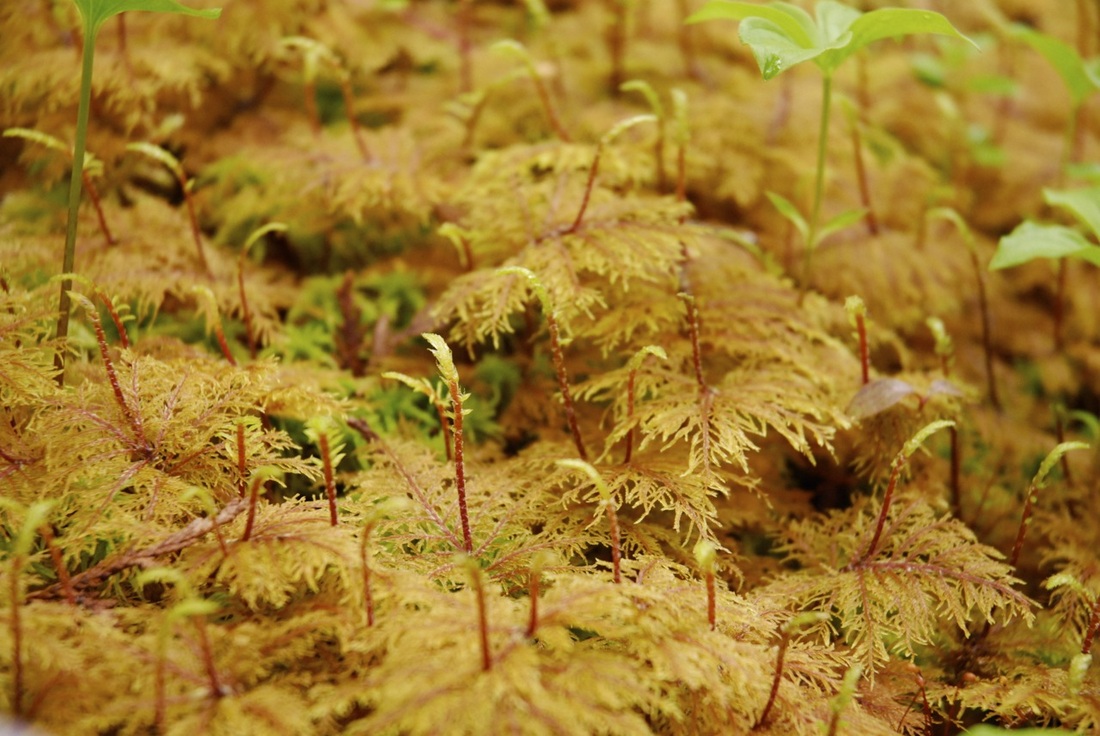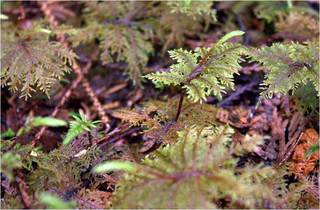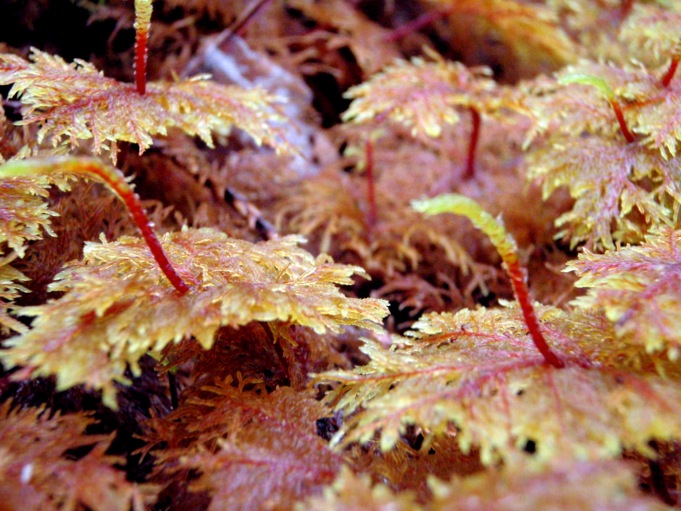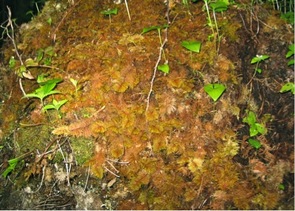Step moss, splendid feather moss, mountain fern moss • Hylocomium splendens • Heiltsuk/Haíɫzaqv - p̓ḷṃ́s
{Hylocomium = woodland inhabitant; splendens = reference to the species' beauty}
Step moss found in forested areas of Calvert Island. Bottom right: step moss often is the major ground cover species in some forests. Bottom left: a piece of partially dead step moss (missing the distinctive red stem colour as a result). Photos by, clockwise from top left: Kelly Fretwell, Teegan Bennington, Sienna Hamilton, and Christina Meschkat.
Identification
Step moss is a very distinctive moss species. It branches twice pinnately, so that the smaller lower branch forms a "step" with a multitude of small feathery filaments. The upper branch grows upwards at an angle and continues to branch off feathery 'steps.' This diagram clearly illustrates this unique branching system. The filaments that form the steps are usually greenish, though they may partially take on the reddish-brown hue of the stems and branches, giving the moss a brownish-green colour overall. Sporophytes are uncommon, but can be locally abundant. Step moss plants found on the coast are sometimes recognized as a distinct subspecies (ssp. giganteum), as they are often many times larger than plants growing in more interior locations.
Click here for a more detailed description and some helpful illustrations.
Habitat & Range
Step moss tends to form carpets of loosely interwoven branches in coniferous forests, where it is often the major ground cover species. It is particularly common in red cedar and hemlock-dominated forests. It prefers soil rich in calcium and decomposing organic matter. It often grows on decaying wood as well, and occasionally will grow on the branches and trunks of live trees. It is more common at low and middle elevations, though it does grow in alpine habitats. Coastal step moss plants are commonly associated with lanky moss (as well as other species of that genus) and goose-necked moss. Step moss is found throughout much of BC and in other cooler North America climates, as well as New Zealand.
Similar Species
Other moss species may appear similarly fern-like and elaborately branched, but none have the reddish stems and the same organized, step-like branching system. Thuidium species (such as T. recognitum) are elaborately branched and feathery, have a distinctly different branching structure, and do not have red stems.
Intriguing Info
Step moss grows one 'step' per year - meaning the age of a plant can be approximated by counting its steps.
iNaturalist
https://www.inaturalist.org/taxa/122555-Hylocomium-splendens
Step moss is a very distinctive moss species. It branches twice pinnately, so that the smaller lower branch forms a "step" with a multitude of small feathery filaments. The upper branch grows upwards at an angle and continues to branch off feathery 'steps.' This diagram clearly illustrates this unique branching system. The filaments that form the steps are usually greenish, though they may partially take on the reddish-brown hue of the stems and branches, giving the moss a brownish-green colour overall. Sporophytes are uncommon, but can be locally abundant. Step moss plants found on the coast are sometimes recognized as a distinct subspecies (ssp. giganteum), as they are often many times larger than plants growing in more interior locations.
Click here for a more detailed description and some helpful illustrations.
Habitat & Range
Step moss tends to form carpets of loosely interwoven branches in coniferous forests, where it is often the major ground cover species. It is particularly common in red cedar and hemlock-dominated forests. It prefers soil rich in calcium and decomposing organic matter. It often grows on decaying wood as well, and occasionally will grow on the branches and trunks of live trees. It is more common at low and middle elevations, though it does grow in alpine habitats. Coastal step moss plants are commonly associated with lanky moss (as well as other species of that genus) and goose-necked moss. Step moss is found throughout much of BC and in other cooler North America climates, as well as New Zealand.
Similar Species
Other moss species may appear similarly fern-like and elaborately branched, but none have the reddish stems and the same organized, step-like branching system. Thuidium species (such as T. recognitum) are elaborately branched and feathery, have a distinctly different branching structure, and do not have red stems.
Intriguing Info
Step moss grows one 'step' per year - meaning the age of a plant can be approximated by counting its steps.
iNaturalist
https://www.inaturalist.org/taxa/122555-Hylocomium-splendens
References
Pojar, J. and MacKinnon, A. (1994). Plants of Coastal British Columbia. Vancouver, BC: Lone Pine Publishing. P. 474.
Schofield, W. Hylocomium splendens (Hedw.) B.S.G. In Klinkenberg, Brian. (Ed.). E-Flora BC: Electronic Atlas of the Plants of British Columbia. Lab for Advanced Spatial Analysis, Department of Geography, University of British Columbia, Vancouver. Accessed 29/08/2013.
Authors and editors of page
Kelly Fretwell and Brian Starzomski (2013).
Pojar, J. and MacKinnon, A. (1994). Plants of Coastal British Columbia. Vancouver, BC: Lone Pine Publishing. P. 474.
Schofield, W. Hylocomium splendens (Hedw.) B.S.G. In Klinkenberg, Brian. (Ed.). E-Flora BC: Electronic Atlas of the Plants of British Columbia. Lab for Advanced Spatial Analysis, Department of Geography, University of British Columbia, Vancouver. Accessed 29/08/2013.
Authors and editors of page
Kelly Fretwell and Brian Starzomski (2013).








